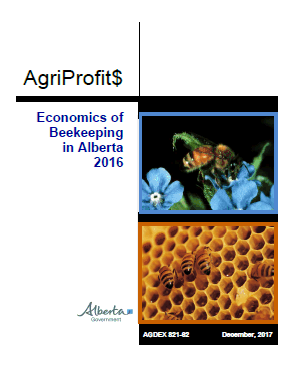| |
 Economics and Competitiveness Economics and Competitiveness

EXECUTIVE SUMMARY
Costs and returns for beekeeping in Alberta have been monitored by the Economics Section of Alberta Agriculture and Forestry since the early 1970s. In winter 2016-17, about 47 beekeepers across the province were surveyed personally to obtain their 2016 costs and returns information. Thirty two (32) out of these 47 beekeepers produced only honey, eight (8) rented their hives for pollination and extracted honey also and the remaining seven (7) primarily produced honey and sold bees as queens, bee nucs and hives. The largest beekeeper operated 8,000 hives and the smallest beekeeper had five hives. These 47 beekeepers managed 62,912 hives, representing 20 percent of the total number of hives in the province in 2016.
This report provides details on total value of production (bulk honey sales, other honey sales and inventory and miscellaneous income) for the three beekeeping enterprise activities (honey production, pollination and bee sales). It also provides estimates of cash costs, operator and family labour, capital costs and net returns (management indicators). The report also contain historical data and trends on the number of beekeepers, number of colonies, colonies per beekeeper, production, honey price and farm cash receipts in Alberta and Canada from 1985 to 2016. In addition, it provides statistics on honey and bee exports and imports.
The report shows a comparison of honey costs and returns for Alberta as well as by region and by size of operation. The results show that beekeepers that kept less than 100 hives achieved the highest return to equity in comparison to other groups. This could be explained by their high value of production due to direct market sales of honey. The multiple regression coefficients show that a one percent increase in total variable costs and total capital costs will correspondingly increase the total value of production of these honey producers by 0.71 percent and 0.35 percent respectively. Sugar feeding costs, total labour costs and number of hives were found to have no statistically significant impact on the total value of production of honey producers.
Those who provided pollination services had comparable costs and made slightly more money than those who produced only honey. Similarly, the bee sales group made more money compared with those who produced only honey. The information presented in the report can be used for several purposes including program evaluation and policy development for the beekeeping industry in Alberta. It could also serve as a guide to producers.
Click here for a pdf of the full report.
For other years costs and returns information. |
|